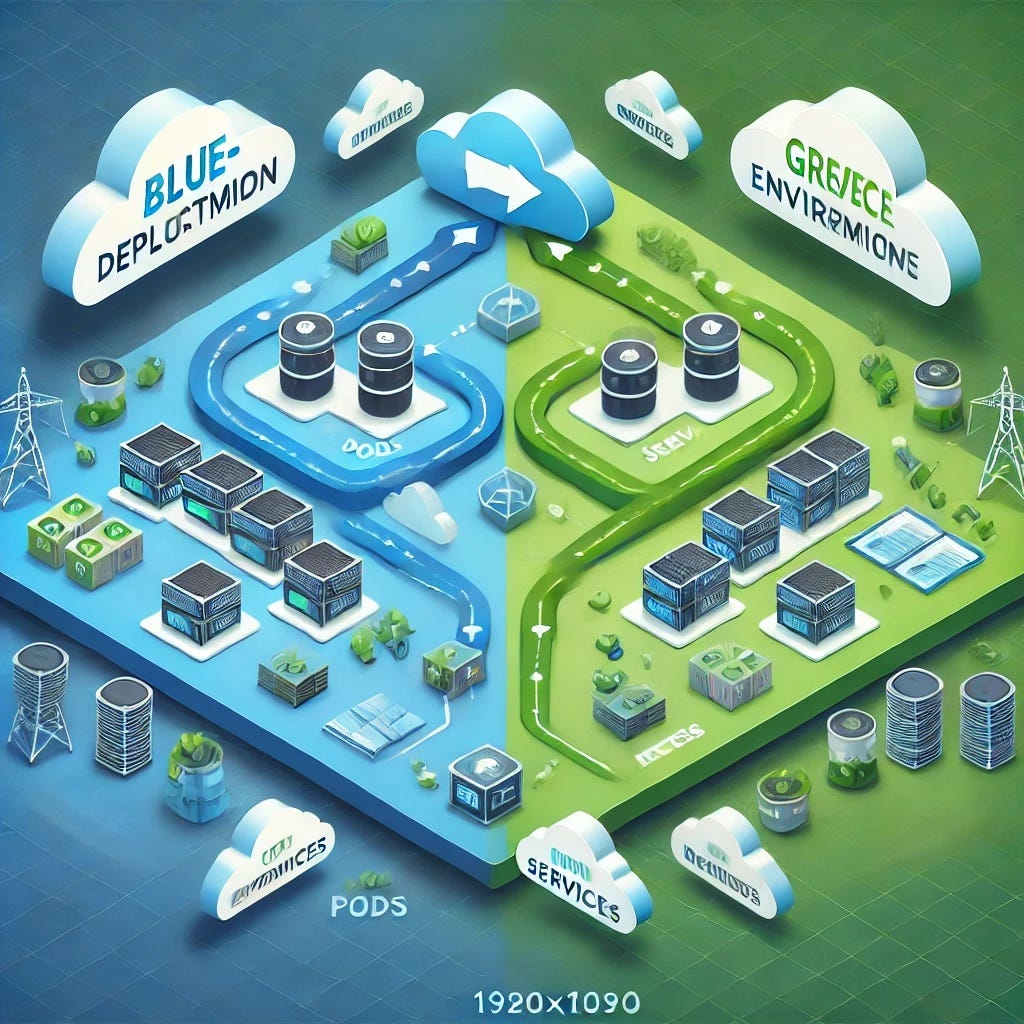Blue-Green Deployment Strategy with Kubernetes
A Blue-Green Deployment strategy is a powerful method for minimizing downtime and risk during application updates. This approach involves running two separate environments: one for the current live version (blue) and another for the new version being deployed (green). The process allows you to seamlessly switch traffic between these two environments, ensuring zero downtime while providing the flexibility to test the new version in production before making it fully live. In a Kubernetes environment, this strategy is implemented using deployments to manage application versions and services to route traffic between them. This tutorial will guide you through the process of implementing a Blue-Green Deployment strategy in Kubernetes, ensuring a smooth and reliable application upgrade with the ability to quickly roll back if needed.
Blue-Green Deployment Strategy
To successfully implement a Blue-Green Deployment in Kubernetes, it’s crucial to understand the foundational principles of this deployment strategy and how it fits into the Kubernetes ecosystem.
What is Blue-Green Deployment?
Blue-Green Deployment is a release management technique aimed at reducing downtime and deployment risks. The concept revolves around maintaining two identical environments for your application:
The Blue Environment represents the current stable production version of your application that actively serves user traffic, while the Green Environment is a clone of the Blue Environment, containing the new version of your application and prepared for deployment.
In this setup, user traffic is initially routed to the blue environment. When the new version in the green environment is ready, the traffic is seamlessly redirected to the green environment. If any issues are identified in the green environment post-deployment, traffic can easily be switched back to the blue environment.
This strategy is particularly valuable for achieving zero downtime during deployments and providing a straightforward rollback mechanism. By isolating the production environment (blue) from the new deployment (green), you can ensure stability and minimize the impact of errors.
How Does It Work in Kubernetes?
Kubernetes is a container orchestration platform that provides the perfect infrastructure to implement Blue-Green Deployments. It utilizes deployments, services, and labels to orchestrate the environments and route traffic dynamically.
Deployments: In Kubernetes, deployments are used to manage the lifecycle of application versions. Separate deployments are created for the blue and green environments, with each deployment managing a group of pods (replicas) running the application.
Labels and Selectors: Labels are used to tag resources in Kubernetes. For a Blue-Green Deployment, labels like version: blue and version: green can be used to differentiate between the two environments. Selectors in Kubernetes services use these labels to direct traffic to the appropriate environment.
Services: Kubernetes services act as stable endpoints for accessing pods. During a Blue-Green Deployment, the service selector can be updated to route traffic from the blue deployment to the green deployment.
By leveraging these Kubernetes primitives, you can orchestrate a smooth traffic switch between application versions with minimal effort.
Advantages of Blue-Green Deployment
Blue-Green Deployments offer several key advantages for production environments:
Zero Downtime: Since the blue and green environments run in parallel, traffic can be switched seamlessly, eliminating any downtime for users.
Testing in Production: The green environment can be tested in the live production environment without impacting users. This allows teams to verify functionality, monitor metrics, and detect potential issues before fully switching traffic.
Simplified Rollback: If the green environment has any critical bugs or issues, traffic can be quickly reverted to the blue environment, ensuring minimal disruption.
Improved Stability: By isolating the two environments, the risk of impacting production during deployments is significantly reduced.
Challenges of Blue-Green Deployment
Despite its advantages, Blue-Green Deployment also comes with some challenges. Running two environments simultaneously can require more resources, as you need sufficient capacity to host both the blue and green environments at the same time. This might be a consideration in resource-constrained environments. Additionally, the strategy requires careful coordination to ensure that all dependencies, such as databases or external services, are compatible between the two environments during the switch.
When to Use Blue-Green Deployment
Blue-Green Deployment is ideal for applications that require high availability and cannot tolerate downtime, making it well-suited for scenarios involving frequent deployments with minimal disruption, strict SLAs for uptime, and the need for rapid rollback in case of deployment failure. This strategy is widely adopted in industries such as e-commerce, finance, and SaaS, where user experience and application stability are paramount.
By understanding the core principles of Blue-Green Deployment and how Kubernetes can facilitate its implementation, you can set a strong foundation for deploying applications with confidence and reliability. In the next part, we will begin the practical implementation by setting up the blue environment.


